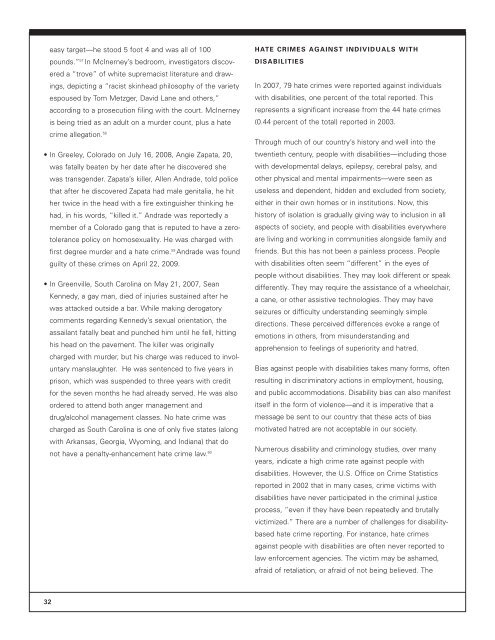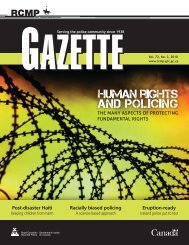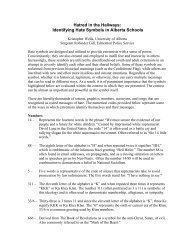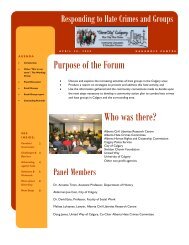Confronting the New Faces of Hate - Alberta Hate Crimes Committee
Confronting the New Faces of Hate - Alberta Hate Crimes Committee
Confronting the New Faces of Hate - Alberta Hate Crimes Committee
Create successful ePaper yourself
Turn your PDF publications into a flip-book with our unique Google optimized e-Paper software.
easy target—he stood 5 foot 4 and was all <strong>of</strong> 100<br />
pounds.” 57 In McInerney’s bedroom, investigators discovered<br />
a “trove” <strong>of</strong> white supremacist literature and drawings,<br />
depicting a “racist skinhead philosophy <strong>of</strong> <strong>the</strong> variety<br />
espoused by Tom Metzger, David Lane and o<strong>the</strong>rs,”<br />
according to a prosecution filing with <strong>the</strong> court. McInerney<br />
is being tried as an adult on a murder count, plus a hate<br />
crime allegation. 58<br />
• In Greeley, Colorado on July 16, 2008, Angie Zapata, 20,<br />
was fatally beaten by her date after he discovered she<br />
was transgender. Zapata’s killer, Allen Andrade, told police<br />
that after he discovered Zapata had male genitalia, he hit<br />
her twice in <strong>the</strong> head with a fire extinguisher thinking he<br />
had, in his words, “killed it.” Andrade was reportedly a<br />
member <strong>of</strong> a Colorado gang that is reputed to have a zerotolerance<br />
policy on homosexuality. He was charged with<br />
first degree murder and a hate crime. 59 Andrade was found<br />
guilty <strong>of</strong> <strong>the</strong>se crimes on April 22, 2009.<br />
• In Greenville, South Carolina on May 21, 2007, Sean<br />
Kennedy, a gay man, died <strong>of</strong> injuries sustained after he<br />
was attacked outside a bar. While making derogatory<br />
comments regarding Kennedy’s sexual orientation, <strong>the</strong><br />
assailant fatally beat and punched him until he fell, hitting<br />
his head on <strong>the</strong> pavement. The killer was originally<br />
charged with murder, but his charge was reduced to involuntary<br />
manslaughter. He was sentenced to five years in<br />
prison, which was suspended to three years with credit<br />
for <strong>the</strong> seven months he had already served. He was also<br />
ordered to attend both anger management and<br />
drug/alcohol management classes. No hate crime was<br />
charged as South Carolina is one <strong>of</strong> only five states (along<br />
with Arkansas, Georgia, Wyoming, and Indiana) that do<br />
not have a penalty-enhancement hate crime law. 60<br />
HATE CRIMES AGAINST INDIVIDUALS WITH<br />
DISABILITIES<br />
In 2007, 79 hate crimes were reported against individuals<br />
with disabilities, one percent <strong>of</strong> <strong>the</strong> total reported. This<br />
represents a significant increase from <strong>the</strong> 44 hate crimes<br />
(0.44 percent <strong>of</strong> <strong>the</strong> total) reported in 2003.<br />
Through much <strong>of</strong> our country’s history and well into <strong>the</strong><br />
twentieth century, people with disabilities—including those<br />
with developmental delays, epilepsy, cerebral palsy, and<br />
o<strong>the</strong>r physical and mental impairments—were seen as<br />
useless and dependent, hidden and excluded from society,<br />
ei<strong>the</strong>r in <strong>the</strong>ir own homes or in institutions. Now, this<br />
history <strong>of</strong> isolation is gradually giving way to inclusion in all<br />
aspects <strong>of</strong> society, and people with disabilities everywhere<br />
are living and working in communities alongside family and<br />
friends. But this has not been a painless process. People<br />
with disabilities <strong>of</strong>ten seem “different” in <strong>the</strong> eyes <strong>of</strong><br />
people without disabilities. They may look different or speak<br />
differently. They may require <strong>the</strong> assistance <strong>of</strong> a wheelchair,<br />
a cane, or o<strong>the</strong>r assistive technologies. They may have<br />
seizures or difficulty understanding seemingly simple<br />
directions. These perceived differences evoke a range <strong>of</strong><br />
emotions in o<strong>the</strong>rs, from misunderstanding and<br />
apprehension to feelings <strong>of</strong> superiority and hatred.<br />
Bias against people with disabilities takes many forms, <strong>of</strong>ten<br />
resulting in discriminatory actions in employment, housing,<br />
and public accommodations. Disability bias can also manifest<br />
itself in <strong>the</strong> form <strong>of</strong> violence—and it is imperative that a<br />
message be sent to our country that <strong>the</strong>se acts <strong>of</strong> bias<br />
motivated hatred are not acceptable in our society.<br />
Numerous disability and criminology studies, over many<br />
years, indicate a high crime rate against people with<br />
disabilities. However, <strong>the</strong> U.S. Office on Crime Statistics<br />
reported in 2002 that in many cases, crime victims with<br />
disabilities have never participated in <strong>the</strong> criminal justice<br />
process, “even if <strong>the</strong>y have been repeatedly and brutally<br />
victimized.” There are a number <strong>of</strong> challenges for disabilitybased<br />
hate crime reporting. For instance, hate crimes<br />
against people with disabilities are <strong>of</strong>ten never reported to<br />
law enforcement agencies. The victim may be ashamed,<br />
afraid <strong>of</strong> retaliation, or afraid <strong>of</strong> not being believed. The<br />
32







